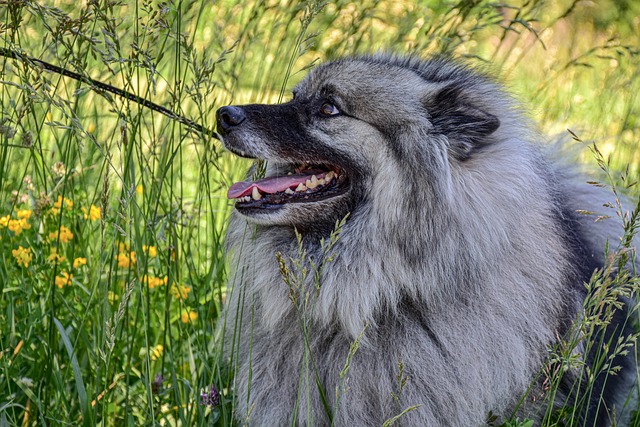


The Keeshond is a medium-sized, friendly, and fluffy dog breed with a distinctive fox-like expression. Known for its thick double coat, distinctive "mane" of fur around the neck, and expressive eyes, the Keeshond is often recognized for its beauty as much as its personality. It is a companion dog through and through, with a loyal and affectionate nature. The Keeshond was originally bred to be a guard dog and watchdog, and it has a reputation for being alert and intelligent. Today, they are mostly family pets, known for their gentle disposition and charming demeanor.
The Keeshond's history can be traced back to the Netherlands, where it was used as a guard dog for riverboats and as a watchdog for homes and farms. The breed is named after the 18th-century Dutch politician and patriot, Cornelis de Gyselaer, whose family crest featured the Keeshond. The breed was popular in the Netherlands and later spread to Germany and other parts of Europe. In the 18th and 19th centuries, the Keeshond was especially favored by Dutch bargemen. The breed’s popularity declined in the 20th century but was revived after World War II. The American Kennel Club (AKC) recognized the Keeshond in 1930, and it has since become a well-loved companion dog worldwide.
The Keeshond is a medium-sized dog with a thick, luxurious double coat that requires regular grooming. Males typically weigh between 45 to 60 pounds, while females are slightly smaller, weighing between 35 to 50 pounds. The breed stands between 17 to 18 inches at the shoulder. Their most distinctive physical feature is the thick mane of fur around their neck, which gives them a fox-like or lion-like appearance. The coat can come in shades of gray, black, and cream, with a lighter undercoat. The Keeshond has a wedge-shaped head with small, erect ears, dark eyes that convey an intelligent and alert expression, and a curled tail that rests over the back. Their striking appearance, combined with their confident stance, makes them one of the most recognizable breeds in the dog world.
The Keeshond is known for its friendly, affectionate, and sociable nature. These dogs are people-oriented and generally do well in families, getting along well with children and other pets. They are loyal and form strong bonds with their families, often becoming very attached to their owners. The Keeshond is also known for being alert and vigilant, making them good watchdogs. While they are not typically aggressive, they are often vocal and will bark to alert their owners of any potential intruders or changes in their environment. Despite their watchful nature, Keeshonds are not overly territorial and are usually welcoming to guests once they are properly introduced.
The Keeshond is an active breed that enjoys regular exercise, but it does not require excessive amounts of physical activity. A daily walk or two, along with some playtime in a secure yard, is usually sufficient to keep the Keeshond healthy and happy. These dogs have a good amount of energy and enjoy engaging in activities with their owners, such as fetch or agility. However, they are not hyperactive and are generally content with moderate activity levels. It’s important to note that Keeshonds enjoy mental stimulation, so puzzle toys and games that challenge their intelligence can also be beneficial in keeping them engaged. As with any dog, regular exercise helps maintain their overall health and prevents obesity, which can be a concern for this breed.
Keeshonds are intelligent and eager to please, making them relatively easy to train. However, they can sometimes exhibit an independent streak, so consistency and patience are essential. Early socialization is important for the Keeshond, as exposure to different people, animals, and environments helps ensure they grow up to be well-rounded adults. The breed tends to be friendly with strangers once they feel comfortable, but they may be cautious or reserved initially. Training should focus on positive reinforcement techniques, as Keeshonds respond well to praise, treats, and rewards. They can also excel in obedience and agility training, particularly when kept engaged and mentally stimulated.
The Keeshond is generally a healthy breed, but like many purebred dogs, it can be prone to certain health conditions. Some of the more common health issues include hip dysplasia, hypothyroidism, cataracts, and progressive retinal atrophy. Regular veterinary check-ups are essential to detect and manage any potential health concerns early. As a double-coated breed, Keeshonds require regular grooming to maintain their beautiful coat. This includes brushing at least two to three times a week to prevent matting and reduce shedding. During shedding seasons, more frequent grooming may be necessary. Additionally, it is important to clean their ears, trim their nails, and brush their teeth regularly to maintain overall health and hygiene.
The average lifespan of a Keeshond is around 12 to 15 years. This is typical for medium-sized breeds, although individual lifespans can vary depending on genetics, health care, and lifestyle. Regular veterinary care, a healthy diet, and an active lifestyle are important factors in helping Keeshonds live long and healthy lives. Like all dogs, it is important to monitor them for signs of aging, including changes in activity levels, mobility, or eating habits, and address any health concerns promptly with the help of a veterinarian.
© copyright Dog Compendium 2024 - 2025